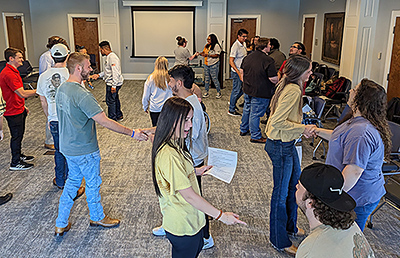Students Learn Value of Making a Connection for Future Careers

In school, in work, and in life, it’s important to make connections. That’s the lesson SMC students learned from guest speaker Thomas Dismukes, an internationally renowned motivational speaker from York, SC, who recently shared his knowledge with the Capstone class.
“If all things are equal, people would rather do business with people they get along with,” Dismukes told the class. “Connections are critical, and we’ve lost the art of person-to-person interaction and making a connection.”
Throughout his one-hour speech, Dismukes went beyond sharing his six key steps in making a connection, he had the group out of their seats playing out the steps in real-time to learn the techniques for themselves.
Students not only learned the techniques but the reason and value behind them. Dismukes and a partner developed the six steps after a conversation about how they decide to hire someone. He said his friend, who hires people for a multi-national company, said he often makes a decision about a candidate within the first 10 seconds of meeting them based on how they make a connection.
The six steps he shared with the students are:
- A firm handshake – shows confidence and gets their attention.
- A good look in the eye – lack of eye contact says you’re not into the interaction.
- A good, hearty smile while you’re talking – puts people at ease and holds their attention.
- Use the person’s name – people like to talk and hear about themselves and shows you’re paying attention.
- Find a common bond – makes a deeper connection.
- Affirm them – giving a genuine affirmation of an accomplishment or action shows you care.
Students were walked through the steps one-by-one, building on the previous step and learning to combine them into a single interaction. The lessons elicited a lot of giggles and diverted eyes at first, but as students gained more confidence they genuinely performed the tasks.
Dismukes shared the importance of the lessons by explaining that not everyone in a room will have the same beliefs and values and that it’s important to find a common bond to bridge those differences.

“Seventy-five percent of the people in the room don’t think like you, and 25 percent think the opposite of you, and that’s OK,” he told the students. He added that the six steps is a way to find a connection.
As the students worked through the steps, several showed hesitation with approaching someone they didn’t know. As they continued, they were surprised with the common bond’s they found they had with others in the room they hadn’t know very well before. In the end, all said they were more comfortable with process and were confident the steps would help them in the future.
The presentation hit home with the seniors who are finishing their Capstone project and preparing for graduation. The Capstone is a final project seniors are required to complete to implement the career development skills they have learned.
SMC’s career development curriculum is required for bachelor degree candidates and teaches students skills they will need when interviewing and entering the workforce. From professional communication to problem solving to critical thinking, students learn skills that when combined with their academic education will make them more marketable to companies after they graduate.
